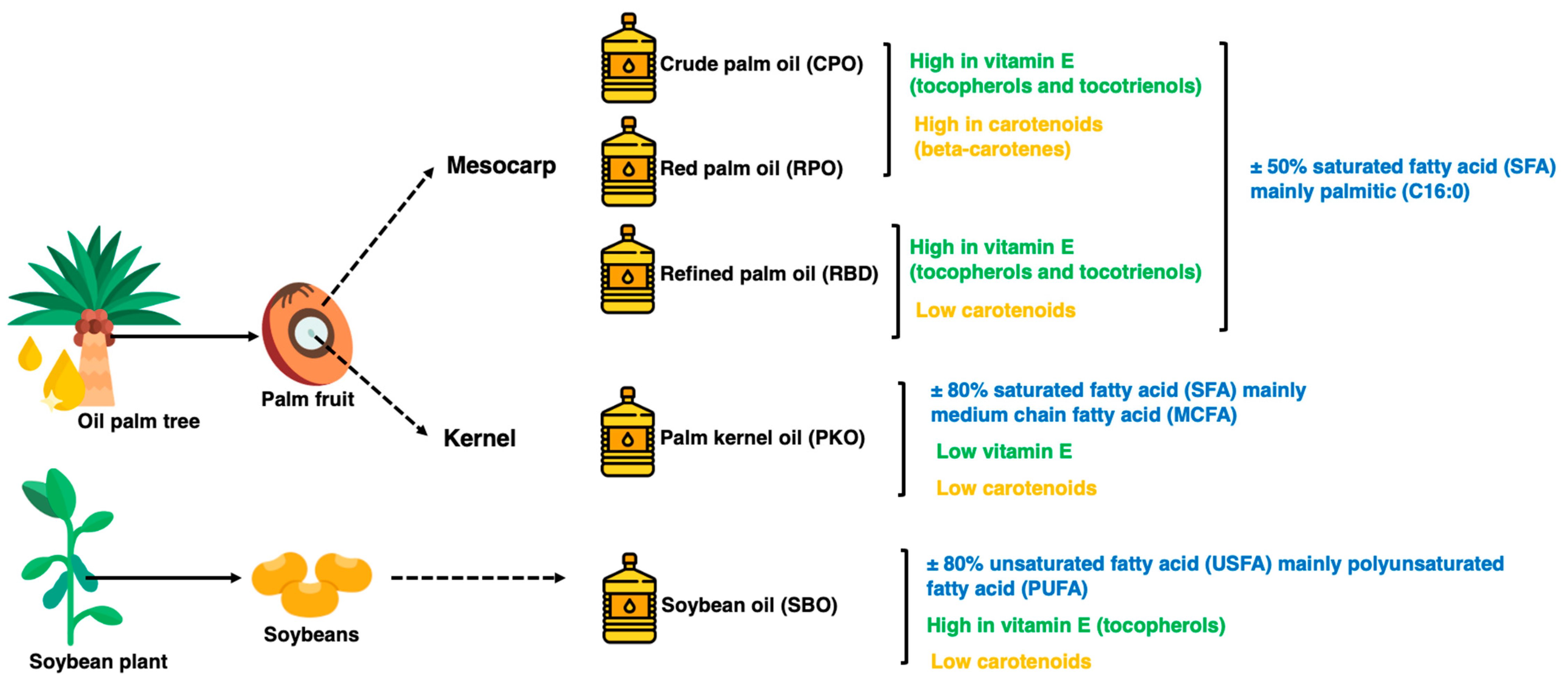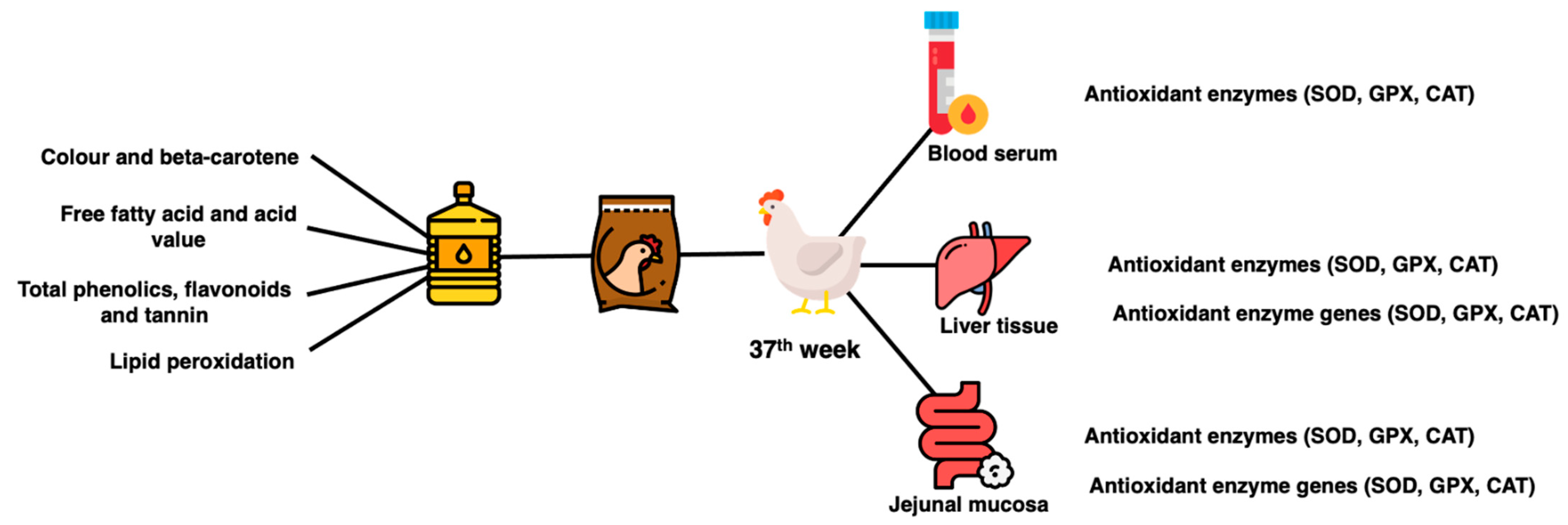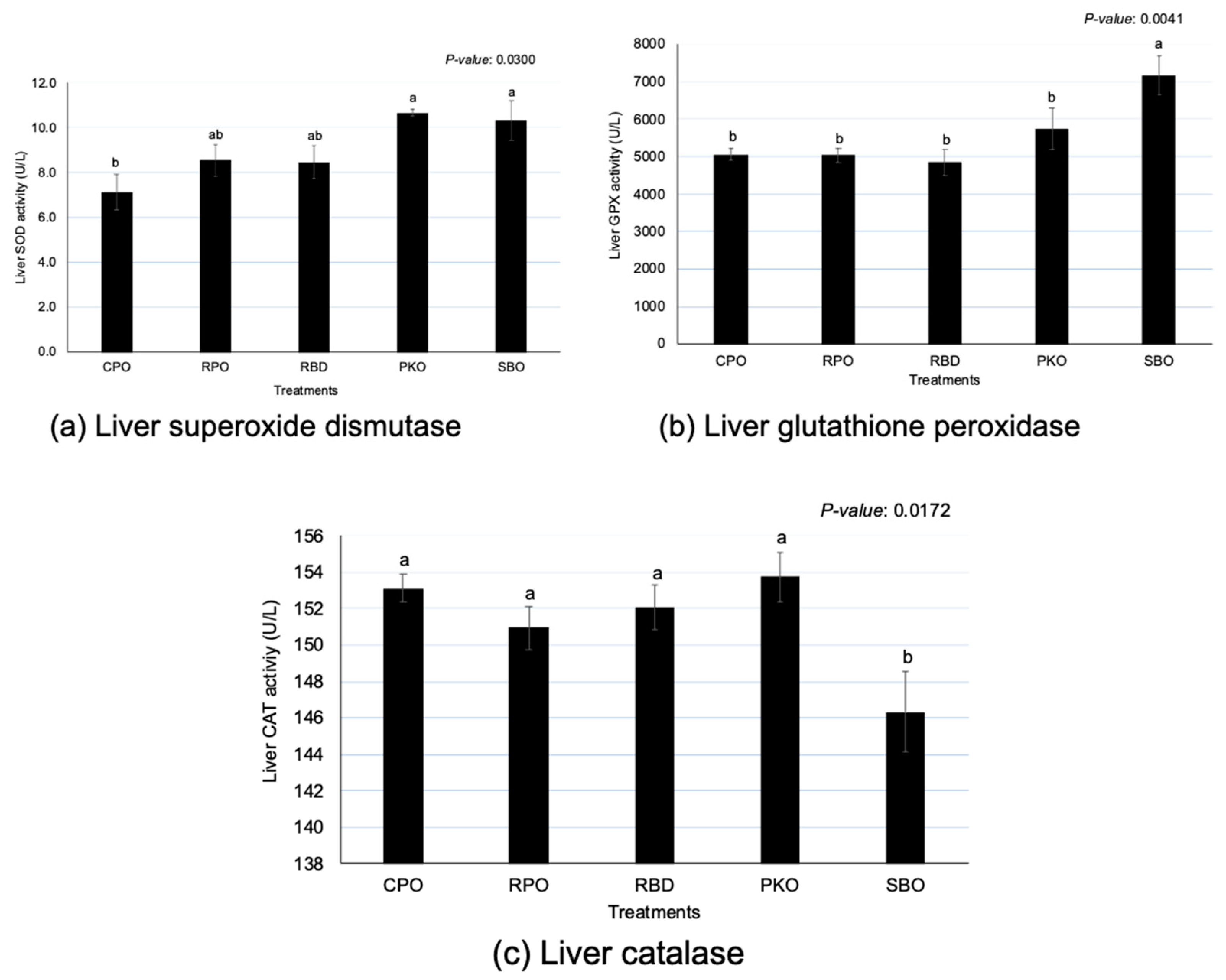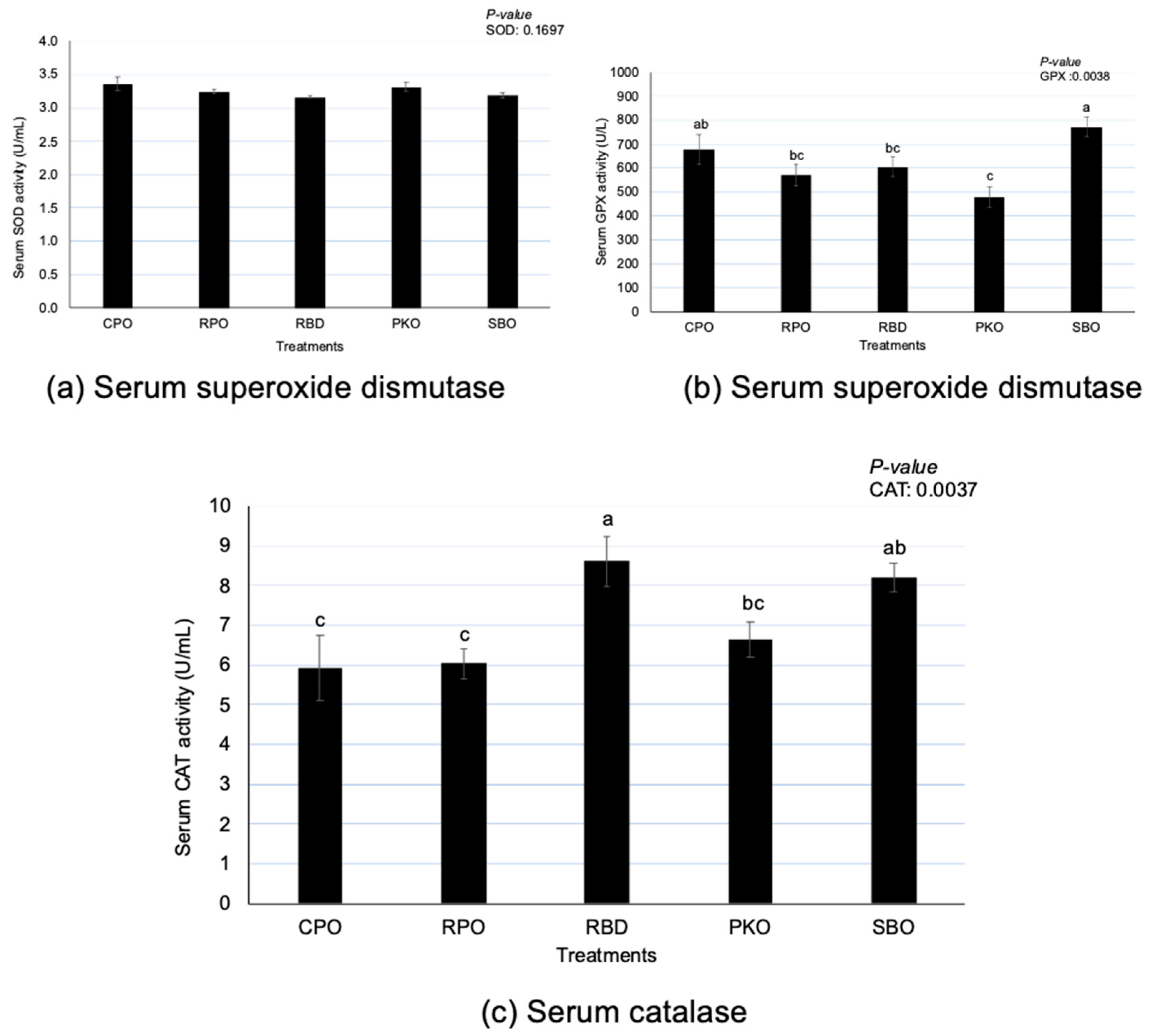Antioxidant Enzyme System Modulation by Dietary Palm Oils, Palm Kernel Oil and Soybean Oil in Laying Hens
Abstract
Simple Summary
Abstract
1. Introduction
2. Materials and Methods
2.1. Source of Oils
2.2. Color, β-Carotene, Free Fatty Acid and Acid Value Determination of Oils
2.3. Phenolic, Flavonoid, Tannin and Lipid Peroxidation Determination of Oils
2.4. Animal, Management and Dietary Treatments of Feeding Trial
2.5. Sample Collection and Analysis
2.6. Serum, Liver and Intestinal Mucosa Antioxidant Enzymes Activity
2.7. Liver and Intestinal Mucosa Antioxidant Enzymes Gene Expression
2.8. Experimental Design and Statistical Analysis
3. Results
3.1. FFA, AV, β-Carotene and Color of Oils
3.2. Total Phenolics, Flavonoids, Tannin and TBARS of Oils
3.3. Liver Antioxidant Enzymes
3.4. Serum Antioxidant Enzymes
3.5. Intestinal Mucosa Antioxidant Enzymes
3.6. Liver and Mucosa Antioxidant Enzyme Gene Expression
4. Discussion
4.1. FFA, AV and β-Carotene and Color
4.2. Total Phenolics, Flavonoids, Tannin and TBARS of Oils
4.3. Antioxidant Enzymes of Liver
4.4. Antioxidant Enzymes of Serum
4.5. Antioxidant Enzymes of Intestinal Mucosa
4.6. Antioxidant Enzyme Gene Expression of Liver and Intestinal Mucosa
5. Conclusions
Author Contributions
Funding
Institutional Review Board Statement
Informed Consent Statement
Data Availability Statement
Acknowledgments
Conflicts of Interest
References
- Gao, Z.; Zhang, J.; Li, F.; Zheng, J.; Xu, G. Effect of Oils in Feed on the Production Performance and Egg Quality of Laying Hens. Animals 2021, 11, 3482. [Google Scholar] [CrossRef] [PubMed]
- Izuddin, W.I.; Loh, T.C.; Akit, H.; Nayan, N.; Noor, A.M.; Foo, H.L. Influence of Dietary Palm Oils, Palm Kernel Oil and Soybean Oil in Laying Hens on Production Performance, Egg Quality, Serum Biochemicals and Hepatic Expression of Beta-Carotene, Retinol and Alpha-Tocopherol Genes. Animals 2022, 12, 3156. [Google Scholar] [CrossRef] [PubMed]
- Izuddin, W.I.; Loh, T.C.; Nayan, N.; Akit, H.; Noor, A.M.; Foo, H.L. Blood lipid profiles, fatty acid deposition and expression of hepatic lipid and lipoprotein metabolism genes in laying hens fed palm oils, palm kernel oil and soybean oil. Front. Vet. Sci. 2023, 10, 1192841. [Google Scholar]
- Mba, O.I.; Dumont, M.-J.; Ngadi, M. Influence of palm oil, canola oil and blends on characteristics of fried plantain crisps. Br. Food J. 2015, 117, 1793–1807. [Google Scholar] [CrossRef]
- Edem, D. Palm oil: Biochemical, physiological, nutritional, hematological and toxicological aspects: A review. Plant Foods Hum. Nutr. 2002, 57, 319–341. [Google Scholar] [CrossRef] [PubMed]
- Choe, E.; Min, D.B. Mechanisms and factors for edible oil oxidation. Compr. Rev. Food Sci. Food Saf. 2006, 5, 169–186. [Google Scholar] [CrossRef]
- Silva, F.A.; Borges, F.; Ferreira, M.A. Effects of phenolic propyl esters on the oxidative stability of refined sunflower oil. J. Agric. Food Chem. 2001, 49, 3936–3941. [Google Scholar] [CrossRef]
- Hamilton, R. The Chemistry of Rancidity in Foods. Rancidity Foods 1994, 3, 1–21. [Google Scholar]
- Yun, J.-M.; Surh, J. Fatty acid composition as a predictor for the oxidation stability of Korean vegetable oils with or without induced oxidative stress. Prev. Nutr. Food Sci. 2012, 17, 158. [Google Scholar] [CrossRef]
- Liu, H.-R.; White, P.J. Oxidative stability of soybean oils with altered fatty acid compositions. J. Am. Oil Chem. Soc. 1992, 69, 528–532. [Google Scholar] [CrossRef]
- Morales, M.T.; Przybylski, R. Olive oil oxidation. In Handbook of Olive Oil; Springer: Berlin/Heidelberg, Germany, 2013; pp. 479–522. [Google Scholar]
- Mishra, B.; Jha, R. Oxidative stress in the poultry gut: Potential challenges and interventions. Front. Vet. Sci. 2019, 6, 60. [Google Scholar] [CrossRef] [PubMed]
- Surai, P.F.; Kochish, I.I.; Fisinin, V.I.; Kidd, M.T. Antioxidant defence systems and oxidative stress in poultry biology: An update. Antioxidants 2019, 8, 235. [Google Scholar] [CrossRef] [PubMed]
- Weydert, C.J.; Cullen, J.J. Measurement of superoxide dismutase, catalase and glutathione peroxidase in cultured cells and tissue. Nat. Protoc. 2010, 5, 51–66. [Google Scholar] [CrossRef]
- Sengupta, A.; Ghosh, M.; Bhattacharyya, D. In vitro antioxidant assay of medium chain fatty acid rich rice bran oil in comparison to native rice bran oil. J. Food Sci. Technol. 2015, 52, 5188–5195. [Google Scholar] [CrossRef] [PubMed]
- Surai, P.F. Selenium in Poultry Nutrition and Health; Wageningen Academic Publishers: Wageningen, The Netherlands, 2018. [Google Scholar]
- Attia, Y.A.; Al-Harthi, M.A.; Abo El-Maaty, H.M. The effects of different oil sources on performance, digestive enzymes, carcass traits, biochemical, immunological, antioxidant, and morphometric responses of broiler chicks. Front. Vet. Sci. 2020, 7, 181. [Google Scholar] [CrossRef]
- Puthpongsiriporn, U.; Scheideler, S. Effects of dietary ratio of linoleic to linolenic acid on performance, antibody production, and in vitro lymphocyte proliferation in two strains of leghorn pullet chicks. Poult. Sci. 2005, 84, 846–857. [Google Scholar] [CrossRef] [PubMed]
- Sijben, J.; De Groot, H.; Nieuwland, M.; Schrama, J.; Parmentier, H. Dietary linoleic acid divergently affects immune responsiveness of growing layer hens. Poult. Sci. 2000, 79, 1106–1115. [Google Scholar] [CrossRef]
- Biswas, A.; Sahoo, J.; Chatli, M. A simple UV-Vis spectrophotometric method for determination of β-carotene content in raw carrot, sweet potato and supplemented chicken meat nuggets. LWT Food Sci. Technol. 2011, 44, 1809–1813. [Google Scholar] [CrossRef]
- Japir, A.A.-W.; Salimon, J.; Derawi, D.; Bahadi, M.; Al-Shuja’a, S.; Yusop, M.R. Physicochemical characteristics of high free fatty acid crude palm oil. OCL 2017, 24, D506. [Google Scholar] [CrossRef]
- Severo, J.; Tiecher, A.; Chaves, F.C.; Silva, J.A.; Rombaldi, C.V. Gene transcript accumulation associated with physiological and chemical changes during developmental stages of strawberry cv. Camarosa. Food Chem. 2011, 126, 995–1000. [Google Scholar] [CrossRef]
- Ma, C.; Dunshea, F.R.; Suleria, H.A. LC-ESI-QTOF/MS characterization of phenolic compounds in palm fruits (jelly and fishtail palm) and their potential antioxidant activities. Antioxidants 2019, 8, 483. [Google Scholar] [CrossRef] [PubMed]
- Gouveia, S.; Castilho, P.C. Antioxidant potential of Artemisia argentea L’Hér alcoholic extract and its relation with the phenolic composition. Food Res. Int. 2011, 44, 1620–1631. [Google Scholar] [CrossRef]
- Zou, B.; Dong, X.-Q.; Ge, Z.-Z.; Xu, Z.; Du, J.; Li, C.-M. Development of suitable standards for quantitative determination of persimmon phenol contents in Folin-Ciocalteu and vanillin assays. Eur. Food Res. Technol. 2014, 239, 385–391. [Google Scholar] [CrossRef]
- Cao, J.; Li, H.; Xia, X.; Zou, X.-G.; Li, J.; Zhu, X.-M.; Deng, Z.-Y. Effect of fatty acid and tocopherol on oxidative stability of vegetable oils with limited air. Int. J. Food Prop. 2015, 18, 808–820. [Google Scholar] [CrossRef]
- Azizi, M.N.; Loh, T.C.; Foo, H.L.; Akit, H.; Izuddin, W.I.; Shazali, N.; Teik Chung, E.L.; Samsudin, A.A. Chemical Compositions of Brown and Green Seaweed, and Effects on Nutrient Digestibility in Broiler Chickens. Animals 2021, 11, 2147. [Google Scholar] [CrossRef] [PubMed]
- Azizi, M.N.; Loh, T.C.; Foo, H.L.; Akit, H.; Izuddin, W.I.; Yohanna, D. Brown and Green Seaweed Antioxidant Properties and Effects on Blood Plasma Antioxidant Enzyme Activities, Hepatic Antioxidant Genes Expression, Blood Plasma Lipid Profile, and Meat Quality in Broiler Chickens. Animals 2023, 13, 1582. [Google Scholar] [CrossRef] [PubMed]
- Livak, K.J.; Schmittgen, T.D. Analysis of relative gene expression data using real-time quantitative PCR and the 2−ΔΔCT method. Methods 2001, 25, 402–408. [Google Scholar] [CrossRef] [PubMed]
- Win, S.S.; Trabold, T.A. Sustainable waste-to-energy technologies: Transesterification. In Sustainable Food Waste-to-Energy Systems; Elsevier: Amsterdam, The Netherlands, 2018; pp. 89–109. [Google Scholar]
- Mahesar, S.; Sherazi, S.; Khaskheli, A.; Kandhro, A.; Uddin, S. Analytical approaches for free fatty acids assessment in oils and fats. Anal. Methods 2014, 6, 4956–4963. [Google Scholar] [CrossRef]
- Ng, M.H.; Choo, Y.M. Improved method for the qualitative analyses of palm oil carotenes using Uplc. J. Chromatogr. Sci. 2016, 54, 633–638. [Google Scholar] [CrossRef] [PubMed]
- Abdullah, F.; Ismail, R.; Ghazali, R.; Idris, Z. Total phenolic contents and antioxidant activity of palm oils and palm kernel oils at various refining processes. J. Oil Palm Res. 2018, 30, 682–692. [Google Scholar] [CrossRef]
- Velasco, J.; Dobarganes, C. Oxidative stability of virgin olive oil. Eur. J. Lipid Sci. Technol. 2002, 104, 661–676. [Google Scholar] [CrossRef]
- Casas-Grajales, S.; Muriel, P. Antioxidants in liver health. World J. Gastrointest. Pharmacol. Ther. 2015, 6, 59. [Google Scholar] [CrossRef] [PubMed]
- Karadas, F.; Erdoğan, S.; Kor, D.; Oto, G.; Uluman, M. The effects of different types of antioxidants (Se, vitamin E and carotenoids) in broiler diets on the growth performance, skin pigmentation and liver and plasma antioxidant concentrations. Braz. J. Poult. Sci. 2016, 18, 101–116. [Google Scholar] [CrossRef]
- Hassan, H.A. Lipid Peroxidation End-Products as a Key of Oxidative Stress: Effect of Antioxidant on Their Production and Transfer of Free Radicals; IntechOpen: London, UK, 2012. [Google Scholar]
- Sadžak, A.; Mravljak, J.; Maltar-Strmečki, N.; Arsov, Z.; Baranović, G.; Erceg, I.; Kriechbaum, M.; Strasser, V.; Přibyl, J.; Šegota, S. The structural integrity of the model lipid membrane during induced lipid peroxidation: The role of flavonols in the inhibition of lipid peroxidation. Antioxidants 2020, 9, 430. [Google Scholar] [CrossRef] [PubMed]
- Tang, D.; Wu, J.; Jiao, H.; Wang, X.; Zhao, J.; Lin, H. The development of antioxidant system in the intestinal tract of broiler chickens. Poult. Sci. 2019, 98, 664–678. [Google Scholar] [CrossRef] [PubMed]
- Sundram, K.; Sambanthamurthi, R.; Tan, Y.-A. Palm fruit chemistry and nutrition. Asia Pac. J. Clin. Nutr. 2003, 12, 355–362. [Google Scholar] [PubMed]
- Merhan, O. Biochemistry and antioxidant properties of carotenoids. Carotenoids 2017, 5, 51. [Google Scholar]
- Tan, L.; Rong, D.; Yang, Y.; Zhang, B. Effect of oxidized soybean oils on oxidative status and intestinal barrier function in broiler chickens. Braz. J. Poult. Sci. 2018, 20, 333–342. [Google Scholar] [CrossRef]





| CPO | RPO | RBD | PKO | SBO | |
|---|---|---|---|---|---|
| C8:0 | 0.019 | 0.014 | 0.010 | 2.680 | 0.009 |
| C10:0 | 0.021 | 0.019 | 0.015 | 2.776 | 0.006 |
| C12:0 | 0.521 | 0.452 | 0.392 | 44.61 | 0.422 |
| C14:0 | 0.900 | 0.856 | 0.843 | 16.20 | 0.152 |
| C16:0 | 55.54 | 51.85 | 49.80 | 13.44 | 22.37 |
| C18:0 | 3.833 | 3.812 | 3.547 | 2.373 | 5.529 |
| C18:1 | 34.37 | 37.71 | 40.76 | 16.71 | 29.84 |
| C18:2n-6 | 4.606 | 5.087 | 5.564 | 1.420 | 37.22 |
| C18:3n-3 | 0.126 | 0.139 | 0.069 | 0.003 | 4.302 |
| SFA | 60.87 | 57.04 | 53.58 | 81.86 | 28.54 |
| USFA | 39.13 | 42.96 | 46.42 | 18.14 | 71.46 |
| MUFA | 34.39 | 37.73 | 40.79 | 16.72 | 29.88 |
| PUFA | 4.735 | 5.230 | 5.637 | 1.424 | 41.58 |
| CPO | RPO | RBD | PKO | SBO | |
|---|---|---|---|---|---|
| Raw materials (%) | |||||
| Corn | 48.90 | 48.90 | 48.90 | 48.90 | 48.90 |
| Soybean meal | 28.00 | 28.00 | 28.00 | 28.00 | 28.00 |
| Wheat pollard | 8.000 | 8.000 | 8.000 | 8.000 | 8.000 |
| Crude palm oil | 3.000 | - | - | - | - |
| Red palm oil | - | 3.000 | - | - | - |
| Refined palm oil | - | - | 3.000 | - | - |
| Palm kernel oil | - | - | - | 3.000 | - |
| Soybean oil | - | - | - | - | 3.000 |
| DL-Methionine | 0.300 | 0.300 | 0.300 | 0.300 | 0.300 |
| MDCP | 2.300 | 2.300 | 2.300 | 2.300 | 2.300 |
| Calcium carbonate | 8.350 | 8.350 | 8.350 | 8.350 | 8.350 |
| Choline chloride | 0.200 | 0.200 | 0.200 | 0.200 | 0.200 |
| Salt | 0.350 | 0.350 | 0.350 | 0.350 | 0.350 |
| Mineral mix | 0.200 | 0.200 | 0.200 | 0.200 | 0.200 |
| Vitamin mix | 0.200 | 0.200 | 0.200 | 0.200 | 0.200 |
| Antioxidants | 0.100 | 0.100 | 0.100 | 0.100 | 0.100 |
| Toxin binder | 0.100 | 0.100 | 0.100 | 0.100 | 0.100 |
| TOTAL | 100.0 | 100.0 | 100.0 | 100.0 | 100.0 |
| Calculated nutrient (%) | |||||
| ME (kcal/kg) | 2790 | 2790 | 2790 | 2790 | 2790 |
| Crude protein | 17.17 | 17.17 | 17.17 | 17.17 | 17.17 |
| Ether extract | 4.980 | 4.98 | 4.98 | 4.98 | 4.98 |
| Crude fibre | 3.800 | 3.80 | 3.80 | 3.80 | 3.80 |
| Calcium | 4.000 | 4.00 | 4.00 | 4.00 | 4.00 |
| Total phosphorus | 0.840 | 0.84 | 0.84 | 0.84 | 0.84 |
| Avail. phosphorus | 0.460 | 0.46 | 0.46 | 0.46 | 0.46 |
| Methionine | 0.581 | 0.581 | 0.581 | 0.581 | 0.581 |
| Lysine | 0.933 | 0.933 | 0.933 | 0.933 | 0.933 |
| Target Gene | Primer Sequence | Product Size (bp) | Accession No. |
|---|---|---|---|
| GAPDH F | CTGGCAAAGTCCAAGTGGTG | 275 | NM_204305.1 |
| GAPDH R | AGCACCACCCTTCAGATGAG | ||
| SOD F | CACTGCATCATTGGCCGTACCA | 224 | NM_205064.1 |
| SOD R | GCTTGCACACGGAAGAGCAAGT | ||
| GPX F | GCTGTTCGCCTTCCTGAGAG | 118 | NM_001277853.2 |
| GPX R | GTTCCAGGAGACGTCGTTGC | ||
| CAT F | TGGCGGTAGGAGTCTGGTCT | 112 | NM_001031215.2 |
| CAT R | GTCCCGTCCGTCAGCCATTT |
| CPO | RPO | RBD | PKO | SBO | SEM | p-Value | |
|---|---|---|---|---|---|---|---|
| FFA (%) | 8.107 b | 8.787 a | 2.05 d | 4.610 c | 0.770 e | 1.864 | <0.0001 |
| AV (mg KOH/g) | 17.75 b | 19.25 a | 4.490 d | 10.09 c | 1.680 e | 0.517 | <0.0001 |
| β-carotenes (µg/mL) | 4.073 a | 3.800 a | 0.000 b | 0.032 b | 0.000 b | 38.44 | <0.0001 |
| L* | 31.51 b | 16.83 d | 18.02 c | 41.28 a | 18.02 c | 1.984 | <0.0001 |
| a* | 25.61 a | 21.10 b | −2.642 e | 1.584 c | −1.726 d | 2.463 | <0.0001 |
| b* | 49.42 a | 27.02 c | 10.24 d | 43.63 b | 4.746 e | 3.635 | <0.0001 |
| CPO | RPO | RBD | PKO | SBO | SEM | p-Value | |
|---|---|---|---|---|---|---|---|
| TPC (µg GA/mL) | 333.8 a | 321.1 a | 239.0 b | 122.2 c | 11.54 d | 33.21 | <0.001 |
| TFC (µg R/mL) | 232.9 a | 162.8 b | 65.77 d | 111.5 c | 36.98 e | 18.74 | <0.001 |
| TTC (µg C/mL) | 569.7 a | 574.3 a | 129.7 c | 285.6 b | 82.27 d | 56.19 | <0.001 |
| TBARS (µg MDA/g) | 10.95 c | 14.81 c | 6.568 d | 31.30 b | 56.56 a | 4.912 | <0.001 |
| TRT | CPO | RPO | RBD | PKO | SBO | SEM | p-Value |
|---|---|---|---|---|---|---|---|
| Liver | |||||||
| CAT | 2.567 | 1.845 | 2.576 | 1.632 | 1.000 | 0.267 | 0.304 |
| SOD | 1.162 | 0.971 | 0.931 | 1.055 | 1.000 | 0.066 | 0.873 |
| GPX | 0.427 | 0.466 | 0.832 | 0.744 | 1.000 | 0.093 | 0.238 |
| Mucosa | |||||||
| SOD | 0.112 c | 0.281 bc | 0.307 b | 0.447 b | 1.000 a | 0.084 | <0.001 |
| GPX | 0.050 c | 0.116 bc | 0.323 bc | 0.434 b | 1.000 a | 0.098 | 0.001 |
| CAT | 0.151 c | 0.193 c | 0.421 bc | 0.678 ab | 1.000 a | 0.101 | 0.011 |
Disclaimer/Publisher’s Note: The statements, opinions and data contained in all publications are solely those of the individual author(s) and contributor(s) and not of MDPI and/or the editor(s). MDPI and/or the editor(s) disclaim responsibility for any injury to people or property resulting from any ideas, methods, instructions or products referred to in the content. |
© 2023 by the authors. Licensee MDPI, Basel, Switzerland. This article is an open access article distributed under the terms and conditions of the Creative Commons Attribution (CC BY) license (https://creativecommons.org/licenses/by/4.0/).
Share and Cite
Izuddin, W.I.; Loh, T.C.; Nayan, N.; Akit, H.; Foo, H.L.; Noor, A.M. Antioxidant Enzyme System Modulation by Dietary Palm Oils, Palm Kernel Oil and Soybean Oil in Laying Hens. Animals 2023, 13, 2245. https://doi.org/10.3390/ani13142245
Izuddin WI, Loh TC, Nayan N, Akit H, Foo HL, Noor AM. Antioxidant Enzyme System Modulation by Dietary Palm Oils, Palm Kernel Oil and Soybean Oil in Laying Hens. Animals. 2023; 13(14):2245. https://doi.org/10.3390/ani13142245
Chicago/Turabian StyleIzuddin, Wan Ibrahim, Teck Chwen Loh, Nazri Nayan, Henny Akit, Hooi Ling Foo, and Ahmadilfitri Md Noor. 2023. "Antioxidant Enzyme System Modulation by Dietary Palm Oils, Palm Kernel Oil and Soybean Oil in Laying Hens" Animals 13, no. 14: 2245. https://doi.org/10.3390/ani13142245
APA StyleIzuddin, W. I., Loh, T. C., Nayan, N., Akit, H., Foo, H. L., & Noor, A. M. (2023). Antioxidant Enzyme System Modulation by Dietary Palm Oils, Palm Kernel Oil and Soybean Oil in Laying Hens. Animals, 13(14), 2245. https://doi.org/10.3390/ani13142245









